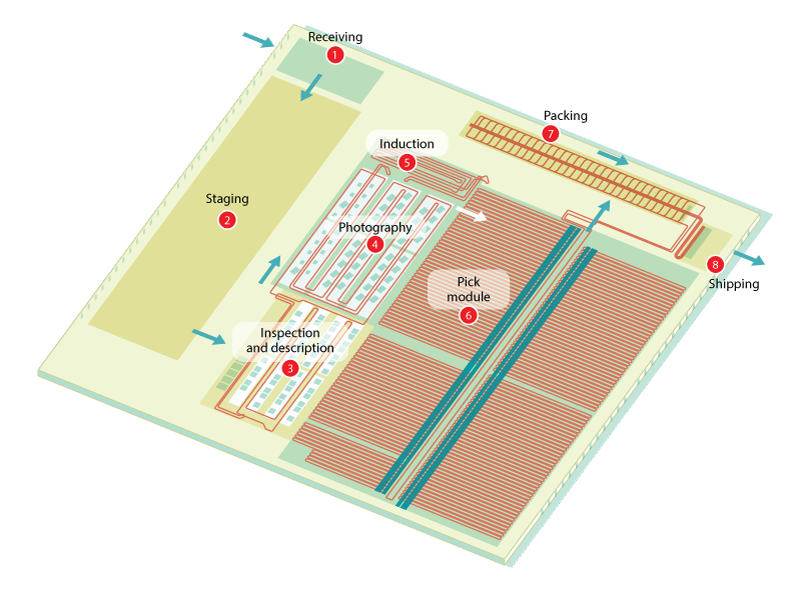Hanging it up at thredUP
thredUP’s design allows the DC to quickly process orders.
Size: 270,157 square feet; one of 4 facilities in thredUP’s network
Products Handled: Secondhand garments, accessories, handbags and shoes
SKUS: More than 3.7 million unique items, typically representing 55,000+ brands
Shifts Per Day/Days Per Week: 3 shifts, 7 days a week
thredUP’s distribution center design is currently operating in four facilities. It uses automated garment-on-hanger (GOH) technology to rapidly process, store and pick thousands of items per day.
Receiving
The receiving process begins when a customer goes online to order a branded bag to ship the clothes they want to sell or donate to thredUP. Customers also have the option to print a label and attach it to any shippable box or bag. The bags are received at a DC incoming area (1), and then sent to an inspection area (2); the company only accepts items that pass a rigorous 12-point quality inspection (3)—from new with tags to gently-worn in good condition.
Items that are accepted are assigned to a hanger that is tracked by a QR code. An associate then completes a comprehensive description that would typically include the type of clothing or accessory; the brand; the color; the size; the material; the washing instructions; and any other information that might typically be included on a label.
Meanwhile, thredUP’s proprietary software algorithms use machine learning to assign a sale price to the item. From there, items are placed onto the GOH conveyor system and automatically routed to the photography area (4). Higher value items are photographed on a mannequin, while lower value items are photographed flat. Pictures are then inspected for quality and posted on the company’s website.
Putaway
Once an item is through the quality control process, the hanger is inducted onto an overhead conveyor (5) and the QR code is scanned. The warehouse management system (WMS) determines which level in the three-level pick module (6) the garment will be stored, including the ground level. The overhead conveyor runs down the middle of the module and includes two tracks: One is for delivery and one for takeaway to packout.
The delivery conveyor routes the item to one of 12 buffer locations on whichever level has been designated for storage. Each buffer location serves a number of horizontal carousels. Similarly, the carousels are configured to hold items depending on size. Long items are stored in carousels with just one level; shorter items are stored in carousels having two levels; and smaller items, like shoes and handbags, are stored in carousels with three levels.
Finally, each carousel is outfitted with an indicator light: A blinking green light means a carousel is turning for a pick; a solid green light means the item is ready to be picked; a blinking yellow light means a carousel is turning for putaway; a solid yellow light means it is ready for putaway; and a red light indicates an emergency e-stop has been activated.
To complete the putaway process, the carousel first spins to an empty location. The associate removes an item from the buffer location, scans the QR code on the hanger and then scans an identification bar code on a carousel frame. The item is now available for sale.
Order fulfillment
Orders are released in waves based on the optimal pick path for one operator. Operators can view a photo of the item to be picked on an iPod worn on their wrist. As an operator is picking from one carousel in his or her area, other carousels are spinning to bring up the next pick. Picked items are placed on the outbound conveyor leading to the packout area (7). The QR code is automatically scanned and the WMS determines which of the 50 packout stations the item will be sent. Some stations handle single item orders and others handle multi-item orders.
Packing and shipping
At the packout station, the system tells the packer what kind of box or envelope should be used. A QR code is applied to the packaging before it’s placed on a shipping conveyor (8). After the package dimensions and weight are automatically measured, the WMS system determines the most cost-effective method of shipment. A shipping label is then automatically printed and applied to the package. Packages are then automatically routed to one of several sortation lanes where they are removed and manually placed into the designated carrier’s shipping container.














